
Khiem Hong Phan, Dung Tri Tran / Tạp chí Khoa học và Công nghệ Đại học Duy Tân 5(48) (2021) 70-78
70
*Corresponding Author: Khiem Hong Phan; Institute of Fundamental and Applied Sciences, Duy Tan University, Ho
Chi Minh City 700000, Vietnam; Faculty of Natural Sciences, Duy Tan University, Da Nang City 550000, Vietnam
Email: phanhongkhiem@duytan.edu.vn
One-loop contributions to in standard model
Đóng góp tích phân Feynman một vòng cho quá trình phân rã hạt vô hướng Higgs
trong mô hình chuẩn
Khiem Hong Phana,b*, Dung Tri Tranc
Phan Hồng Khiêma,b,*, Trần Trí Dũngc
aInstitute of Fundamental and Applied Sciences, Duy Tan University, Ho Chi Minh City 700000, Vietnam
aViện Nghiên cứu Khoa học Cơ bản và Ứng dụng, Trường Đại học Duy Tân, Tp. HCM, Việt Nam
bFaculty of Natural Sciences, Duy Tan University, Da Nang City 550000, Vietnam
bKhoa Khoa học Tự nhiên, Trường Đại học Duy Tân, Đà Nẵng , Việt Nam
cUniversity of Science Ho Chi Minh City, 227 Nguyen Van Cu, District 5, HCM City, Vietnam
cĐại học Khoa học Tự nhiên Tp. HCM, 227 Nguyễn Văn Cừ, Quận 5, Tp. HCM
(Ngày nhận bài: 11/6/2021, ngày phản biện xong: 20/9/2021, ngày chấp nhận đăng: 14/10/2021)
Abstract
One-loop contributions to the decay process in standard model are performed in this paper. The
detailed computations are carried out in unitary gauge. In physical results, we present numerical results for partial decay
width and its distribution. We find that the partial decay width is given to KeV. This result is in the upper bound
of the current experimental data at the Large Hadron Collider.
Keywords: Higgs phenomenology; One-loop corrections; analytic methods for Quantum Field Theory; Dimensional
regularization.
Tóm tắt
Trong bài báo này, chúng tôi tính các đóng góp tích phân Feynman một vòng cho quá trình phân rã hạt vô hướng Higgs
trong mô hình Chuẩn. Tính toán chi tiết được xét trong chuẩn unitary. Trong phần kết quả vật
lý, chúng tôi trình bày kết quả của bề rộng phân rã và các phân bố của bề rộng phân rã cho quá trình trên. Kết quả bề
rộng phân rã nhận được từ tính toán này là $0.466$ KeV và phù hợp với dữ liệu thực nghiệm hiện tại ở máy gia tốc
LHC.
Từ Khóa: Hiện tượng luận hạt vô hướng Higgs; Bổ chính lượng tử; Phương pháp giải tích cho Lý Thuyết trường lượng
tử; Phương pháp chỉnh thứ nguyên.
1. Introduction
After the discovery of the Standard model
like (SM-like) Higgs boson at the Large Hadron
Collider (LHC), one of the main targets at the
High-Luminosity Large Hadron Collider (HL-
LHC) as well as future colliders [1, 2, 3] is to
measure the SM-like Higgs properties. It means
that all couplings of the Higgs to gauge bosons
and matter particles are probed as precise as
possible. From the experimental data, we can
5(48) (2021) 70-78

Khiem Hong Phan, Dung Tri Tran / Tạp chí Khoa học và Công nghệ Đại học Duy Tân 5(48) (2021) 70-78
71
verify the Standard model at higher energy
region as well as extract the contributions of
new physics. In all the Higgs decay modes, the
channel of Higgs boson decay to photon and
missing energy is great of interest the colliders
[4, 5, 6, 7, 8, 9] by following reasons: (i) since
many new particles which are absent in SM
may exchange in the loop diagrams of the
decay process; (ii) new neutral particles rather
than three neutrinos may exist in new physics.
Subsequently, the decay could provide an
important information for testing Higgs sector
as well as probing to dark matter and
constraining new physic parameters.
In order to analyse new physics, we must
understand fully the Standard model
background. Therefore, precise calculations for
are necessary. The relevant
Feynman diagrams for this decay channel start
not at tree level but at one-loop level in the
electroweak interaction. As the above reasons,
we carry out one-loop contributions to the
decay . The calculations are
performed in unitary gauge by using
dimensional regularization. In
phenomenological results,we present the partial
decay width and its distribution in detail. The
partial decay width is to KeV which is in
the upper bound of the present experimental
data at the LHC. Detailed analytical
calculations and physical results for
with are discussed in our forthcoming
paper.
Our paper is organized as follows: In section
2, after describing briefly one-loop tensor
reduction method, detailed calculations for one-
loop contributions to are
explained more. Analytic formulas for one-loop
form factors and phenomenological results are
presented in this section. Conclusions and
outlook are devoted in section .
2. Calculations
In general, one-loop amplitude for the decay
is expressed in terms of one-
loop Feynman tensor integrals which are
reduced frequently into scalar functions. In this
computation, we apply the tensor reduction
method in [10]. The approach will be explained
briefly in the following paragraphs. Firstly, the
definitions for one-loop one-, two-, three-point
tensor integrals with rank are given by
(1)
Where the inverse Feynman propagators are given as follows:
(2)
for . In this equation,
with are the external momenta and are
internal masses in the loops. Note that
thanks to momentum
conservation. Space-time dimension is
and parameter is a renormalization scale.
The explicit reduction formulas for one-loop
one-, two- and three-point tensor integrals up to
rank involving this process are then shown
as follows [10]:
{A;B;C}µ1µ2···µP= (µ2)2−d/2Zddk
(2π)d
kµ1kµ2···kµP
{D1;D1D2;D1D2D3}.
Dj= (k+qj)2−m2
j+iρ,
−

Khiem Hong Phan, Dung Tri Tran / Tạp chí Khoa học và Công nghệ Đại học Duy Tân 5(48) (2021) 70-78
72
(3)
In the above relations, we have utilized the
short notation [10]
. All
scalar coefficients are so-
called Passarino-Veltman functions (PV) in
[10]. Analytic formulas of the PV functions are
well-known and they have been implemented
into package LoopTools [12] for numerical
computations.
2.1 Analytic results
The detailed evaluations for the decay
in unitary gauge in
which only the physical particles appear and
ghosts and Goldstone bosons being absent are
presented in this subsection. The decay channel
consists of boson and fermion internal
particles exchanging in one-loop triangle
diagrams (seen Fig. 1 and Fig. 2 respectively).
The fermion and gauge boson propagators
related to the decay in unitary gauge and the
relevant Feynman rules for the three- and four-
point vertices which we use for this work are
summarized and devoted in Appendix. The
Ward identity is implied for external photon's
on-shell condition as where , are
momentum and polarization vector of photon
respectively. Besides that Dirac equation's
conditions for external electron neutrinos
and are applied as to simplify more the
calculations. Kinematic invariant variables for
this decay process are given
with being the Higgs boson
mass.
Assuming that electron neutrinos are
massless, so that , we then
introduce the following Mandelstam variables
as:
(4)
Figure 1: -boson particles exchanging in one-loop triangle diagrams of in unitary gauge.

Khiem Hong Phan, Dung Tri Tran / Tạp chí Khoa học và Công nghệ Đại học Duy Tân 5(48) (2021) 70-78
73
Figure 2: Fermion particles exchanging in one-loop triangle diagrams of in unitary gauge.
General one-loop amplitude for the decay
channel can be written as follows:
(5)
In this formula, presents for the
contributions of triangle Feynman diagrams
with boson internal lines (shown in Fig. 1).
The term is to the contributions of triangle
Feynman diagrams with fermions exchanging
in the loop (seen in Fig. 2). Each component of
Eq. (5) is expressed in terms of Lorentz
invariant structure as follows:
(6)
Where we have used left-handed projection
operator The calculations
are consistently straightforward and we make
full usage of [13, 14] for handling
all Dirac traces and contracts in general
dimensions. The form factors
are expressed in terms of
scalar coefficients - more specifically, in terms
of Passarino-Veltman functions at arbitrary
are obtained by summing all diagram
amplitudes of each type as follows. In the limit
all scalar Passarino-Veltman
coefficients of the mentioned
form factors are expressed in terms of the
Passarino-Veltman function's basis such as one-
point integrals , two-point integrals and
three-point integrals in [10]. In principle,
each diagram's contribution can be dependent
of ultraviolet cut-off ( -term) and the mass
scale parameter of dimensional regularization
when taking , we confirm that these
terms are cancelled out after summing all
diagrams. As a result, the total amplitude
contributions become consistently finite at
and are independent of . Taking an example,
one-loop triangle amplitude's contributions
related to this decay channel, in particularly,
consist of the ultraviolet divergences that
appear in the scalar two-points integrals and
their own expressions in terms of in
dimensional regularization. When we take into
considerations about difference between two
's, the analytical result becomes finite in terms
of logarithm functions at . Specifically, we
obtain for and as
follows
(7)
B0(M2
H, M2, M2)−B0(q12, M 2, M2) =
=pM4
H−4M4M2
H
M2
H
ln "pM4
H−4M4M2
H+ 2M4−M2
H
2M4#
−pq2
12 −4M4q12
q12
ln "pq2
12 −4M4q12 + 2M4−q12
2M4#,

Khiem Hong Phan, Dung Tri Tran / Tạp chí Khoa học và Công nghệ Đại học Duy Tân 5(48) (2021) 70-78
74
(8)
Moreover, the three-point integral related to this decay channel is also given by finite result in
terms of logarithm functions at as follows:
(9)
By performing explicitly -expansion for the
above form factors, we confirm exactly Ward
identity relation for the -term's
form factors. Therefore, the analytical results at
space-time dimension in terms of
logarithm functions of related masses and
Mandelstam variables for above form factors in
Eq. (6) are expressed as
(10)
B0(P2, M2, M 2)−B0(0, M2, M2) =
= 2 + √P4−4M4P2
P2ln "√P4−4M4P2+ 2M4−P2
2M4#.
C0(0, q12, M2
H, M2, M2, M2) = 1
2(M2
H−q12)×
×(ln2"pM4
H−4M4M2
H+ 2M4−M2
H
2M4#−ln2"pq2
12 −4M4q12 + 2M4−q12
2M4#).
F(W)
1=M2
H−q12
2F(W)
2
=−α2
2M2
HM3
Ws3
W(M2
H−q12)2(q12 −M2
Z+iΓZMZ)×
×(M2
HM2
WhM2
H(q12 −6M2
W) + 12M4
W+ 6M2
Wq12 −2q2
12i×
×ln2"−M2
H+pM4
H−4M2
HM2
W+ 2M2
W
2M2
W#
+M2
Hn2M4
HM2
W−M4
Hq12 + 12M2
HM4
W−4M2
HM2
Wq12
+qq2
12 −4M2
Wq12hM2
H(q12 −2M2
W) + 2M2
W(q12 −6M2
W)i×
×ln "−q12 +pq2
12 −4M2
Wq12 + 2M2
W
2M2
W#
−M2
WhM2
H(q12 −6M2
W) + 12M4
W+ 6M2
Wq12 −2q2
12i×
×ln2"−q12 +pq2
12 −4M2
Wq12 + 2M2
W
2M2
W#
+M2
Hq2
12 −12M4
Wq12 + 2M2
Wq2
12o
+q12qM4
H−4M2
HM2
WhM2
H(2M2
W−q12) + 12M4
W−2M2
Wq12i×
×ln "−M2
H+pM4
H−4M2
HM2
W+ 2M2
W
2M2
W#)



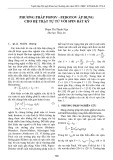
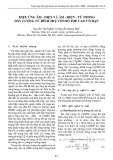
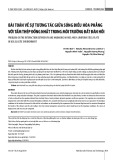
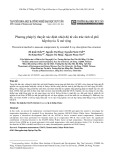
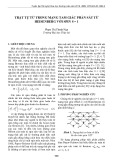
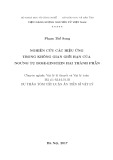










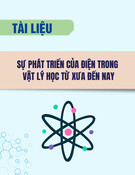
![Bộ câu hỏi lý thuyết Vật lý đại cương 2 [chuẩn nhất/mới nhất]](https://cdn.tailieu.vn/images/document/thumbnail/2025/20251003/kimphuong1001/135x160/74511759476041.jpg)
![Bài giảng Vật lý đại cương Chương 4 Học viện Kỹ thuật mật mã [Chuẩn SEO]](https://cdn.tailieu.vn/images/document/thumbnail/2025/20250925/kimphuong1001/135x160/46461758790667.jpg)




